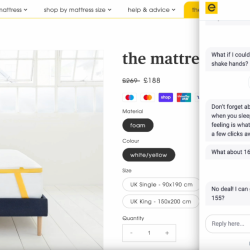If you want to be seen, you’ve got to get online.
Well, no surprise there! Given that we have all spent a year in lockdown it stands to reason that the virtual has quickly outstripped the physical. The world’s appetite for digital content is at an all-time high – and it shows no sign of abating. In the UK, we can’t get enough: where the average individual spent 5 hours and 28 minutes online in 2020, this year we’ve already seen that time rise to 6 hours and 26 mins, a jump of nearly an hour per day.
That is a lot of opportunities for brands to connect with users.
And while Brits may be desperate for lockdown to end, they are less keen to back into the shops: the latest study shows that over 17m Brits are planning to switch to online shopping permanently.
Retailer, or publisher?
This opportunity does not come without risks. For retailers, online shopping comes with increased costs, from ecommerce site maintenance, to shipping, to increased returns. For brands, this shift means traditional physical retail trade and shopper marketing won’t have the same reach and impact. This presents online retailers with an enviable opportunity – and often necessity to make retail media the hot new toy on the media buyer’s shelf
Taking a step back: we should first define ‘retail media’. The term refers to any advertising within retailer sites and apps. Typically, it is done by brands that directly sell products with the retailer, though this is not a necessity.
And when you think that two-thirds of online product searches start on a retailer site, it becomes clear how brands can use retail media to boost their visibility on the “digital shelf”. Typical online ad formats – native and display ads, for example – then become akin to an endcap or special in-aisle feature in a physical store. But it’s so much more than that: being online, rather than in-store, means that you can fully track the actions of everyone who saw the message.
For the retailers themselves, the opportunity is almost too good to be true – an extra revenue stream built on monetising existing assets: eyeballs on your site and your customer data.
Customer data, already a source of immense value, just got that bit more valuable. Understandably, the knee-jerk reaction is for retailers to protect this asset at all costs. They pull up the drawbridge and, taking a lesson from pre-eminent online advertisers like Facebook or Amazon, create a ‘walled garden’ approach to their data. The retailer decides that they will control the platform, offering brands carefully targeted advertising, though entirely on the retailer’s terms.
It seems a sensible approach but it’s not. It’s antiquated and, for brands, a frustrating and worn-out model.
Open to change
In fact, far from protecting their data, retailers are limiting their ability to monetise it. In recent years, brand marketing has moved on – the channel has become irrelevant and all that matters is the getting the right message to the right audiences (so much for Marshall McLuhan’s “the medium is the message”!). With so much data readily available, advertising is about maximising the return on investment, getting bang for your buck. And the more data an advertiser can see, the more significant the ROI.
Just like the rest of us, marketers are looking for an easy life – so the more compatible your advertising platform, the quicker it is to buy ads, the easier it is to analyse the performance of those ads and the more attractive you are to marketing teams.
Therefore, a retailer that sets itself apart from the wider advertising ecosystem, that exists as an outlier in terms of access, risks making themselves an after-thought. Sure, you might still get some dedicated trade spend, but you are very unlikely to see wider marketing spend shifting onto your platform. If you are not part of a single, seamless ecosystem, then you can’t be compared to other platforms and you can’t outperform those rivals. Loch Rose, chief analytics officer at Epsilon sums up the situation very well:
“Marketers spend a lot of their time trying to decide which parts of their programs are underperforming so they can move their investments into the higher investing parts. The lack of insight from walled gardens makes that very hard to do.”
Allow a look behind the curtain
Instead, retailers should embrace the concept of open-internet advertising. They should become media moguls – looking carefully at how well they are set up for easy-access by media agencies. Know the power of your audience but be realistic about it. And know where the real value of your platform lies; it is not solely in providing eyeballs for brands, but in the insight and understanding that businesses can take from the data. For retailers, opening up and allowing your advertising customers to analyse the performance of their activities is infinitely more valuable to them than a few sale conversions – and when they then put further effort and action into improving their performance on your platform, it is ultimately you that benefits.
Critically, becoming a ‘media mogul’ is about more than just updating old technology. While the latter is simply a new way to run an old model – essentially taking trade business and selling it in an online format – media moguls have access budgets they would have never seen in a pre-online era.
I am reminded of a conversation I recently had with Stuart Johnston, Omnichannel Commerce Director at Publicis. He echoed these points, noting that:
“It’s a win-win situation for all parties. For retailers, those who open up their data and targeting capability via open networks are far more likely to attract advertising revenue from agencies and clients alike. It’s a great opportunity to monetise their most important commodity – data – and they just need to take it. For brands, retailer intent and purchase data that doesn’t rely on third-party cookies will go a long way in offering more measurable impact. And for the consumer, it’s a personalised experience that seamlessly integrates into their shopping experience.”
The world is coming online at pace, and a retailer’s digital storefronts are often the first thing that a consumer sees. Retailers must trust in their value, trust in their potential and be the media mogul they know they can be. This is their chance to elevate their status, reaching above and beyond trade budgets to become a central force in helping brands reach their audiences.
Hear our call: retailers, you must break down those walls!
Featured image: Golden Sikorka / Shutterstock.com


































